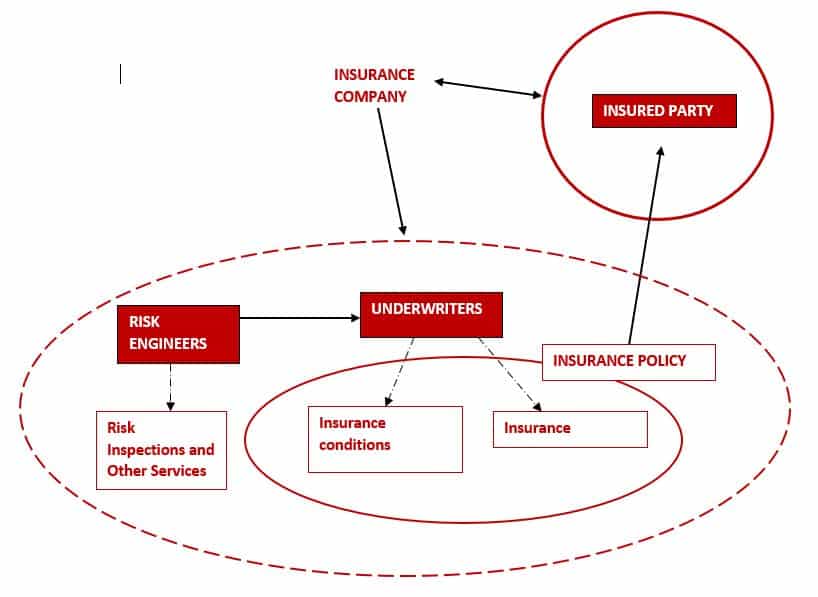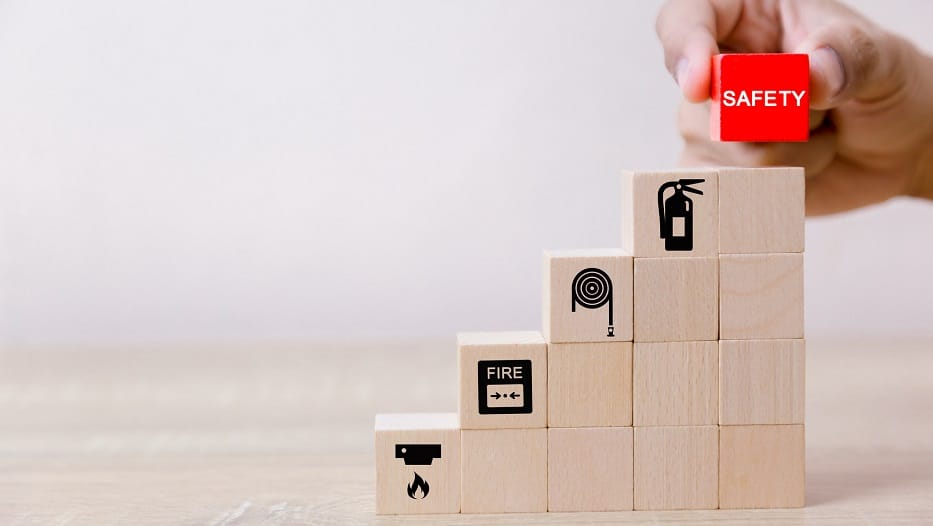Julia Maria Gomez de Avila Segade | 01/12/2022
In order to understand the stimulating role of an insurance company’s risk engineer in improving firefighting measures, we must first get to know the role, responsibilities and tasks of the risk engineer within the insurance company.
The insurance company is made up of sales offices and insurance agents, which are one of the main sources of business, and internal areas, such as underwriting areas (Underwriters); engineering areas (Risk Engineers); claims areas (Claims Managers), and other equally important areas such as finance, legal, operations, marketing, etc.
Within this structure, risk engineers work supporting underwriters, who are responsible for setting insurance conditions according to the customer and type of business and are also in direct contact with claims managers to provide technical support if necessary.
Insurance Company Risk Engineer: Objective, Responsibilities and Tasks
One of the main objectives of an insurance company’s risk engineer is to support the underwriter in the underwriting process, making it easier for the underwriter to identify, analyze and assess the risks, the levels of risk control and the protection they have.
For this purpose, the risk engineers carry out risk inspection visits to the insured party’s facilities, in which they proceed to collect data, which will then serve to prepare a report that will include the analysis, evaluation and control of the risks.
This report prepared by risk engineers will support the underwriter in the underwriting process.
On the other hand, the Risk Engineer advises on risk improvement/reduction measures to ensure adequate and acceptable levels of control for both the insured party and the insurance company.
In addition, our engineers at MAPFRE Global Risks lead the Account Engineering Service by performing and coordinating other Engineering Services included in our Catalog, aimed at knowledge transfer, consulting for the reinforcement of security aspects and advising on matters of high specialization.
Responsibilities of a Risk Engineer include:
- Risk analysis and assessment at insured companies considering the coverages of “property damage (fire, explosion, weather damage etc.), “machinery breakdown” and “loss of profit” associated with the material damage and/or machinery breakdown
- Drafting of improvement plans (recommendations)
- Technical services adapted for the insured party
The main tasks carried out by a risk engineer in the area of engineering at MAPFRE Global Risks include:
- Field inspection visits or remote inspections.
These visits are usually carried out in person and, for this purpose, the engineer travels to the facilities of the insured party for data collection, which will then serve for the risk analysis and assessment process. However, in recent years, and mainly due to the pandemic, MAPFRE GLOBAL RISKS engineering has carried out a number of specific inspections virtually or in a hybrid manner, in which online meetings and video inspections have been held with the use of glasses or mobile phones and software adapted to this.
Currently, at MAPFRE Global Risks, remote inspections are carried out mainly for the follow-up of recommendations and/or for training and/or technical support to engineers from other countries.
- Preparation of inspection reports including risk analysis and assessment.
With the information collected during the visit, we proceed to analyze a series of aspects (type of activity, risks associated with the activity, type of construction, process safety measures, prevention measures and protection measures), preparing an inspection report in which all the aspects analyzed and their evaluation are included, thus determining the level of risk control of the facilities visited.
- Reporting improvement plans (recommendations).
All aspects of improvement observed during the inspection visit are listed in the report called “Improvement Plan”. It develops the recommendations that are considered necessary to be carried out by the insured party to ensure acceptable levels of risk control.
- Advice on the design, installation, commissioning of firefighting measures.
In cases where the insured party is going to carry out the improvement of the level of fire protection in their facilities, with the installation of new protection systems (sprayers, deluge systems, etc.), MAPFRE GLOBAL RISKS engineering department provides advice, both in the design and at the time of the installation and receipt of the means of protection.
- Technical advice and thermographies.
Technical support to the insured party in technical aspects such as thermal images, business continuity plans, installation of solar panels in existing buildings, etc.
- Training
Internal and external training in risk analysis and evaluation, maintenance of fire protection means, thermal images, emergency plans, business continuity plans, etc.
- Technical loss analysis (root cause analysis).
Risk Analysis and Assessment by Insurance Company Risk Engineer
When analyzing and evaluating risks at insured companies, we must take into account the following main aspects: 
- Activity (automotive, food, telecommunications, steel, paper, wood etc.)
- Type of risks by activity
- Process conditions
- Machinery type
- How hazards are controlled and protected in the plant
- Construction/compartmentalization
- Raw material, finished product
- Storage Type
- Maintenance and inspection
- Prevention measures
- Fire protection measures
When we talk about firefighting measures, we are referring to manual means (extinguishers, BIEs, hydrants, etc.); fire detection and alarm systems; automatic extinguishing means (sprayers, deluge systems, gas flood systems, etc.); fire water supply system and their maintenance and inspection.
Comments found on firefighting during hazard inspections at insured companies
- Insufficient number of manual extinguishing equipment (extinguishers, BIEs, hydrants) or poor accessibility.
- No passive means of protection (walls and fire doors, cable gap clearance seals, etc.), as well as active protection (automatic fire detection and suppression) in high risk areas.
- Inadequate water supply system for extinguishing equipment.
- Poor maintenance and inspection of extinguishing equipment.
Recommendations after risk inspections at insured companies
- Review and expand the number of manual extinguishing equipment (extinguishers, BIEs, hydrants).
- Study and install means of passive protection, as well as active protection in high-risk areas.
- Ensure water supply system requirements and reliability for extinguishing media.
- Improve and reinforce maintenance of extinguishing media.
Technical support in implementing firefighting improvement plans
The MAPFRE Global Risks engineering department provides technical support to the insured party when implementing the improvement plans (recommendations).
Support from MAPFRE Global Risks Engineering includes advice on the design, installation, receipt of firefighting and training.
Advice on the design, installation, receipt of fire protection means includes the following:
- Analysis of the technical project, which provides, among others, the justification for the sizing of the necessary means of extinguishing. Starting point for adequate protection.
- Tracking the assembly and receiving phase of the fire protection installation.
- Verification that necessary information is provided to the user (insured party), including maintenance books.
As for training, it focuses on both passive and active protection, and includes knowledge on aspects such as maintenance, inspection and field testing of fire protection measures.
Article author:
María Teresa Queralt, Technical Department Expert at MAPFRE Global Risks.
Keep reading… Measures when reviewing fire protection






